实验六 继承定义与使用
实验目的与要求:
在软件开发中,通过继承机制,可以利用已有的数据类型来定义新的数据类型。所定义的新的数据类型不仅拥有新定义的成员,而且还同时拥有旧的成员。因此,类的继承性使所建立的软件具有开放性开放性、可扩充性,这是信息组织与分类的行之有效的方法,通过类的继承关系,使公共的特性能够共享,简化了对象、类的创建工作量,增加了代码的可重用性。运行时多态性是面向对象程序设计代码重用的一个最强大机制,Java多态性的概念也可以被说成“一个接口,多个方法”。Java实现运行时多态性的基础是动态方法调度,它是一种在运行时而不是在编译期调用重载方法的机制。方法的重写Overriding和重载Overloading是Java多态性的不同表现。重写Overriding是父类与子类之间多态性的一种表现,重载Overloading是一个类中多态性的一种表现。如果在子类中定义某方法与其父类有相同的名称和参数,我们说该方法被重写(Overriding)。子类的对象使用这个方法时,将调用子类中的定义,对它而言,父类中的定义如同被“屏蔽”了。如果在一个类中定义了多个同名的方法,它们或有不同的参数个数或有不同的参数类型,则称为方法的重载(Overloading)。Overloaded的方法是可以改变返回值的类型。方法的重写Overriding和重载Overloading是Java多态性的不同表现。当超类对象引用变量引用子类对象时,被引用对象的类型而不是引用变量的类型决定了调用谁的成员方法,但是这个被调用的方法必须是在超类中定义过的,也就是说被子类覆盖的方法。 (但是如果强制把超类转换成子类的话,就可以调用子类中新添加而超类没有的方法了。
二、(1) 理解继承的定义;(2) 掌握子类的定义要求(3) 掌握多态性的概念及用法;(4) 掌握抽象类的定义及用途;(5) 掌握类中4个成员访问权限修饰符的用途;(6) 掌握抽象类的定义方法及用途;(7)掌握Object类的用途及常用API;(8) 掌握ArrayList类的定义方法及用法;(9) 掌握枚举类定义方法及用途。
2、实验内容和步骤
实验1: 导入第5章示例程序,测试并进行代码注释。
测试程序1:在elipse IDE中编辑、调试、运行程序5-1 (教材152页-153页) ;掌握子类的定义及用法;结合程序运行结果,理解并总结OO风格程序构造特点,理解Employee和Manager类的关系子类的用途,并在代码中添加注释。
测试实验结果如下:

插入此程序的代码并对其进行注释,进行更深一步的理解
ManaManager
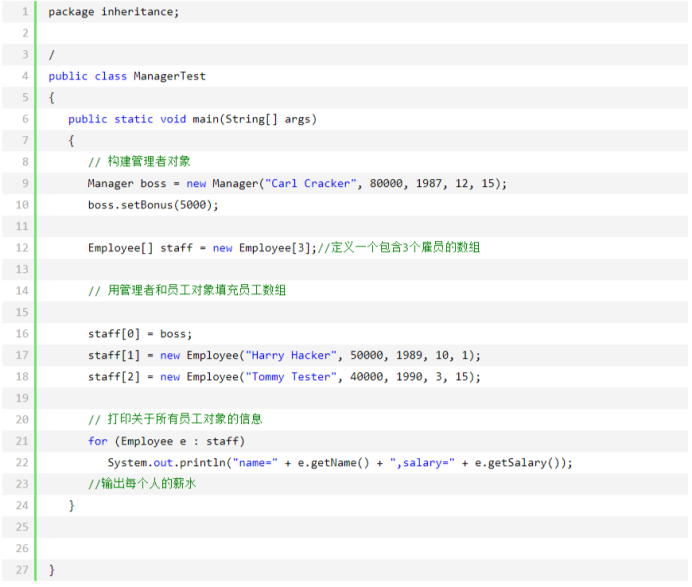
Emloyee:
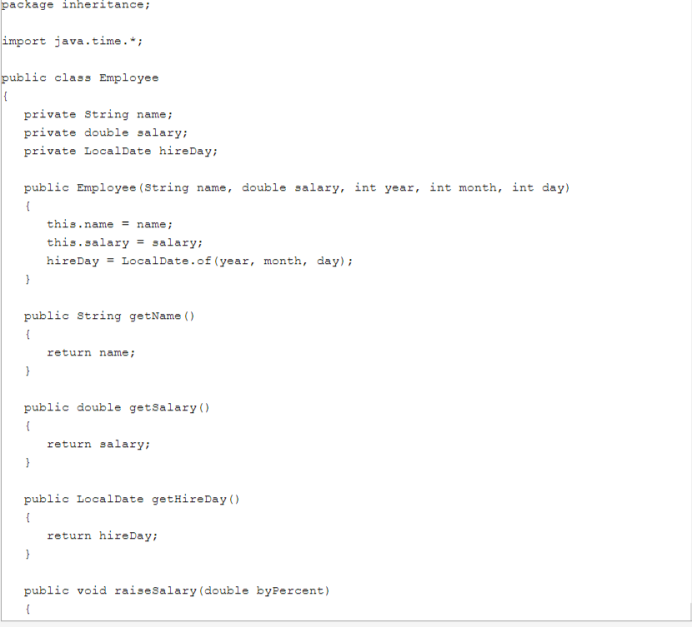


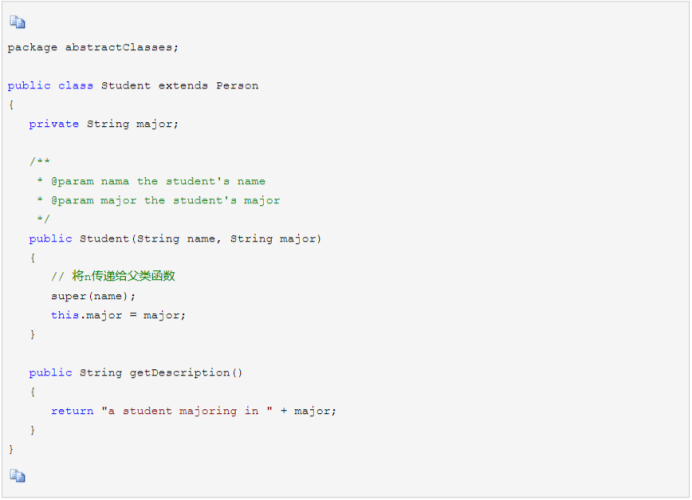
子类的定义:在有继承关系的类中extends前面的类则是子类。
超类和子类都是Java程序员常用的两个类。
测试程序2:
编辑、编译、调试运行教材PersonTest程序(教材163页-165页);
掌握超类的定义及其使用要求;
掌握利用超类扩展子类的要求;
在程序中相关代码处添加新知识的注释。
超类:如果在程序中没有明确的之处超类,Object就是被认为是这个类的超类,如:Public class Employee extebds Object.在java中,每个类都是Object类扩展而来的。当然也可以使用Object类型的变量引用任何类型的对象。
超类扩展子类的要求
代码的注释:

测试程序3:
编辑、编译、调试运行教材程序5-8、5-9、5-10,结合程序运行结果理解程序(教材174页-177页);
掌握Object类的定义及用法;
在程序中相关代码处添加新知识的注释。
Employee.java:
package equals;
import java.time.*;
import java.util.Objects;
public class Employee
{
private String name;
private double salary;
private LocalDate hireDay;
public Employee(String name, double salary, int year, int month, int day)
{
this.name = name;
this.salary = salary;
hireDay = LocalDate.of(year, month, day);
}
public String getName()
{
return name;
}
public double getSalary()
{
return salary;
}
public LocalDate getHireDay()
{
return hireDay;
}
public void raiseSalary(double byPercent)
{
double raise = salary * byPercent / 100;
salary += raise;
}
public boolean equals(Object otherObject)
{
// 看看这些对象是否相同
if (this == otherObject) return true;
// 如果显式参数为空,则必须返回false
if (otherObject == null) return false;
// 如果类不匹配,它们就不能相等
if (getClass() != otherObject.getClass()) return false;
// 现在我们知道otherObject是一个非空雇员
Employee other = (Employee) otherObject;
// 测试字段是否具有相同的值
return Objects.equals(name, other.name) && salary == other.salary && Objects.equals(hireDay, other.hireDay);
}
public int hashCode()
{
return Objects.hash(name, salary, hireDay);
}
public String toString()
{
return getClass().getName() + "[name=" + name + ",salary=" + salary + ",hireDay=" + hireDay
+ "]";
}
}
Manager.java:
package equals;
public class Manager extends Employee//子类Manager继承父类Employee
{
private double bonus;
public Manager(String name, double salary, int year, int month, int day)
{
super(name, salary, year, month, day);
bonus = 0;
}
public double getSalary()
{
double baseSalary = super.getSalary();
return baseSalary + bonus;
}
public void setBonus(double bonus)
{
this.bonus = bonus;
}
public boolean equals(Object otherObject)
{
if (!super.equals(otherObject)) return false;
Manager other = (Manager) otherObject;
// super.equals检查这个和其他属于同一个类
return bonus == other.bonus;
}
public int hashCode()
{
return java.util.Objects.hash(super.hashCode(), bonus);
}
public String toString()
{
return super.toString() + "[bonus=" + bonus + "]";
}
}
Equals.java:
package equals;
/**
* This program demonstrates the equals method.
* @version 1.12 2012-01-26
* @author Cay Horstmann
*/
public class EqualsTest
{
public static void main(String[] args)
{
Employee alice1 = new Employee("Alice Adams", 75000, 1987, 12, 15);
Employee alice2 = alice1;
Employee alice3 = new Employee("Alice Adams", 75000, 1987, 12, 15);
Employee bob = new Employee("Bob Brandson", 50000, 1989, 10, 1);
System.out.println("alice1 == alice2: " + (alice1 == alice2));
System.out.println("alice1 == alice3: " + (alice1 == alice3));
System.out.println("alice1.equals(alice3): " + alice1.equals(alice3));
System.out.println("alice1.equals(bob): " + alice1.equals(bob));
System.out.println("bob.toString(): " + bob);
Manager carl = new Manager("Carl Cracker", 80000, 1987, 12, 15);
Manager boss = new Manager("Carl Cracker", 80000, 1987, 12, 15);
boss.setBonus(5000);
System.out.println("boss.toString(): " + boss);
System.out.println("carl.equals(boss): " + carl.equals(boss));
System.out.println("alice1.hashCode(): " + alice1.hashCode());
System.out.println("alice3.hashCode(): " + alice3.hashCode());
System.out.println("bob.hashCode(): " + bob.hashCode());
System.out.println("carl.hashCode(): " + carl.hashCode());
}
}
package equals;
/**
* This program demonstrates the equals method.
* @version 1.12 2012-01-26
* @author Cay Horstmann
*/
public class EqualsTest
{
public static void main(String[] args)
{
Employee alice1 = new Employee("Alice Adams", 75000, 1987, 12, 15);
Employee alice2 = alice1;
Employee alice3 = new Employee("Alice Adams", 75000, 1987, 12, 15);
Employee bob = new Employee("Bob Brandson", 50000, 1989, 10, 1);
System.out.println("alice1 == alice2: " + (alice1 == alice2));
System.out.println("alice1 == alice3: " + (alice1 == alice3));
System.out.println("alice1.equals(alice3): " + alice1.equals(alice3));
System.out.println("alice1.equals(bob): " + alice1.equals(bob));
System.out.println("bob.toString(): " + bob);
Manager carl = new Manager("Carl Cracker", 80000, 1987, 12, 15);
Manager boss = new Manager("Carl Cracker", 80000, 1987, 12, 15);
boss.setBonus(5000);
System.out.println("boss.toString(): " + boss);
System.out.println("carl.equals(boss): " + carl.equals(boss));
System.out.println("alice1.hashCode(): " + alice1.hashCode());
System.out.println("alice3.hashCode(): " + alice3.hashCode());
System.out.println("bob.hashCode(): " + bob.hashCode());
System.out.println("carl.hashCode(): " + carl.hashCode());
}
}
测试程序4:
在elipse IDE中调试运行程序5-11(教材182页),结合程序运行结果理解程序;
掌握ArrayList类的定义及用法;
在程序中相关代码处添加新知识的注释。
插入程序相关代码
ArrayList.java:
package arrayList;
import java.util.*;
/**
* This program demonstrates the ArrayList class.
* @version 1.11 2012-01-26
* @author Cay Horstmann
*/
public class ArrayListTest
{
public static void main(String[] args)
{
// 用三个Employee对象填充staff数组列表
ArrayList<Employee> staff = new ArrayList<>();
staff.add(new Employee("Carl Cracker", 75000, 1987, 12, 15));
staff.add(new Employee("Harry Hacker", 50000, 1989, 10, 1));
staff.add(new Employee("Tony Tester", 40000, 1990, 3, 15));
// 把每个人的薪水提高5%
for (Employee e : staff)
e.raiseSalary(5);
// 打印所有Employee对象的信息
for (Employee e : staff)
System.out.println("name=" + e.getName() + ",salary=" + e.getSalary() + ",hireDay="
+ e.getHireDay());
}
}
Employee.java:
package arrayList;
import java.time.*;
public class Employee
{
private String name;
private double salary;
private LocalDate hireDay;
public Employee(String name, double salary, int year, int month, int day)
{
this.name = name;
this.salary = salary;
hireDay = LocalDate.of(year, month, day);
}
public String getName()
{
return name;
}
public double getSalary()
{
return salary;
}
public LocalDate getHireDay()
{
return hireDay;
}
public void raiseSalary(double byPercent)
{
double raise = salary * byPercent / 100;
salary += raise;
}
}
package arrayList;
import java.time.*;
public class Employee
{
private String name;
private double salary;
private LocalDate hireDay;
public Employee(String name, double salary, int year, int month, int day)
{
this.name = name;
this.salary = salary;
hireDay = LocalDate.of(year, month, day);
}
public String getName()
{
return name;
}
public double getSalary()
{
return salary;
}
public LocalDate getHireDay()
{
return hireDay;
}
public void raiseSalary(double byPercent)
{
double raise = salary * byPercent / 100;
salary += raise;
}
}
程序测试结果如下:

测试程序5:
编辑、编译、调试运行程序5-12(教材189页),结合运行结果理解程序;
掌握枚举类的定义及用法;
在程序中相关代码处添加新知识的注释。
插入实例程序的代码:
package enums;
import java.util.*;
/**
* This program demonstrates enumerated types.
* @version 1.0 2004-05-24
* @author Cay Horstmann
*/
public class EnumTest
{
public static void main(String[] args)
{
Scanner in = new Scanner(System.in);
System.out.print("Enter a size: (SMALL, MEDIUM, LARGE, EXTRA_LARGE) ");
String input = in.next().toUpperCase();
Size size = Enum.valueOf(Size.class, input);
System.out.println("size=" + size);
System.out.println("abbreviation=" + size.getAbbreviation());
if (size == Size.EXTRA_LARGE)
System.out.println("Good job--you paid attention to the _.");
}
}
enum Size
{
SMALL("S"), MEDIUM("M"), LARGE("L"), EXTRA_LARGE("XL");
private Size(String abbreviation) { this.abbreviation = abbreviation; }
public String getAbbreviation() { return abbreviation; }
private String abbreviation;
}
测试结果如下:
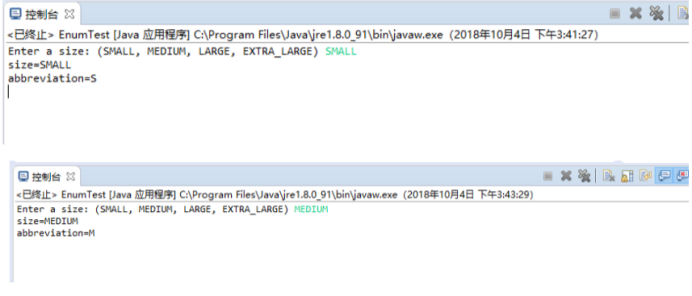
实验2:编程练习1
定义抽象类Shape:
属性:不可变常量double PI,值为3.14;
方法:public double getPerimeter();public double getArea())。
让Rectangle与Circle继承自Shape类。
编写double sumAllArea方法输出形状数组中的面积和和double sumAllPerimeter方法输出形状数组中的周长和。
main方法中
1)输入整型值n,然后建立n个不同的形状。如果输入rect,则再输入长和宽。如果输入cir,则再输入半径。
2) 然后输出所有的形状的周长之和,面积之和。并将所有的形状信息以样例的格式输出。
3) 最后输出每个形状的类型与父类型,使用类似shape.getClass()(获得类型),shape.getClass().getSuperclass()(获得父类型);
思考sumAllArea和sumAllPerimeter方法放在哪个类中更合适?
输入样例:
3
rect
1 1
rect
2 2
cir
1
输出样例:
18.28
8.14
[Rectangle [width=1, length=1], Rectangle [width=2, length=2], Circle [radius=1]]
class Rectangle,class Shape
class Rectangle,class Shape
class Circle,class Shape
程序相关代码:
shape:
package shape;
import java.util.Scanner;
public class Test {
public static void main(String[] args) {
Scanner in = new Scanner(System.in);
System.out.println("个数");
int a = in.nextInt();
System.out.println("种类");
String rect="rect";
String cir="cir";
Shape[] num=new Shape[a];
for(int i=0;i<a;i++){
String input=in.next();
if(input.equals(rect)) {
System.out.println("长和宽");
int length = in.nextInt();
int width = in.nextInt();
num[i]=new Rectangle(width,length);
System.out.println("Rectangle["+"length:"+length+" "+width+"]");
}
if(input.equals(cir)) {
System.out.println("半径");
int radius = in.nextInt();
num[i]=new Circle(radius);
System.out.println("Circle["+"radius:"+radius+"]");
}
}
Test c=new Test();
System.out.println("求和");
System.out.println(c.sumAllPerimeter(num));
System.out.println(c.sumAllArea(num));
for(Shape s:num) {
System.out.println(s.getClass()+","+s.getClass().getSuperclass());
}
}
public double sumAllArea(Shape score[])
{
double sum=0;
for(int i=0;i<score.length;i++)
sum+= score[i].getArea();
return sum;
}
public double sumAllPerimeter(Shape score[])
{
double sum=0;
for(int i=0;i<score.length;i++)
sum+= score[i].getPerimeter();
return sum;
}
}
Test:
package shape;
import java.util.Scanner;
public class Test {
public static void main(String[] args) {
Scanner in = new Scanner(System.in);
System.out.println("个数");
int a = in.nextInt();
System.out.println("种类");
String rect="rect";
String cir="cir";
Shape[] num=new Shape[a];
for(int i=0;i<a;i++){
String input=in.next();
if(input.equals(rect)) {
System.out.println("长和宽");
int length = in.nextInt();
int width = in.nextInt();
num[i]=new Rectangle(width,length);
System.out.println("Rectangle["+"length:"+length+" "+width+"]");
}
if(input.equals(cir)) {
System.out.println("半径");
int radius = in.nextInt();
num[i]=new Circle(radius);
System.out.println("Circle["+"radius:"+radius+"]");
}
}
Test c=new Test();
System.out.println("求和");
System.out.println(c.sumAllPerimeter(num));
System.out.println(c.sumAllArea(num));
for(Shape s:num) {
System.out.println(s.getClass()+","+s.getClass().getSuperclass());
}
}
public double sumAllArea(Shape score[])
{
double sum=0;
for(int i=0;i<score.length;i++)
sum+= score[i].getArea();
return sum;
}
public double sumAllPerimeter(Shape score[])
{
double sum=0;
for(int i=0;i<score.length;i++)
sum+= score[i].getPerimeter();
return sum;
}
}
实验结果如下所示:

实验3: 编程练习2
编制一个程序,将身份证号.txt 中的信息读入到内存中,输入一个身份证号或姓名,查询显示查询对象的姓名、身份证号、年龄、性别和出生地。
插入程序代码:
Main :
本周学习package id1;
import java.io.BufferedReader;
import java.io.File;
import java.io.FileInputStream;
import java.io.FileNotFoundException;
import java.io.IOException;
import java.io.InputStreamReader;
import java.util.ArrayList;
import java.util.Scanner;
public class Main{
private static ArrayList<Student> studentlist;
public static void main(String[] args) {
studentlist = new ArrayList<>();
Scanner scanner = new Scanner(System.in);
File file = new File("D:/身份证号.txt");
try {
FileInputStream fis = new FileInputStream(file);
BufferedReader in = new BufferedReader(new InputStreamReader(fis));
String temp = null;
while ((temp = in.readLine()) != null) {
Scanner linescanner = new Scanner(temp);
linescanner.useDelimiter(" ");
String name = linescanner.next();
String number = linescanner.next();
String sex = linescanner.next();
String year = linescanner.next();
String province =linescanner.nextLine();
Student student = new Student();
student.setName(name);
student.setnumber(number);
student.setsex(sex);
student.setyear(year);
student.setprovince(province);
studentlist.add(student);
}
} catch (FileNotFoundException e) {
System.out.println("学生信息文件找不到");
e.printStackTrace();
} catch (IOException e) {
System.out.println("学生信息文件读取错误");
e.printStackTrace();
}
boolean isTrue = true;
while (isTrue) {
System.out.println("1.按姓名查询");
System.out.println("2.按身份证号查询");
System.out.println("3.退出");
int nextInt = scanner.nextInt();
switch (nextInt) {
case 1:
System.out.println("请输入姓名");
String studentname = scanner.next();
int nameint = findStudentByname(studentname);
if (nameint != -1) {
System.out.println("查找信息为:身份证号:"
+ studentlist.get(nameint).getnumber() + " 姓名:"
+ studentlist.get(nameint).getName() +" 性别:"
+studentlist.get(nameint).getsex() +" 年龄:"
+studentlist.get(nameint).getyaer()+" 地址:"
+studentlist.get(nameint).getprovince()
);
} else {
System.out.println("不存在该学生");
}
break;
case 2:
System.out.println("请输入身份证号");
String studentid = scanner.next();
int idint = findStudentByid(studentid);
if (idint != -1) {
System.out.println("查找信息为:身份证号:"
+ studentlist.get(idint ).getnumber() + " 姓名:"
+ studentlist.get(idint ).getName() +" 性别:"
+studentlist.get(idint ).getsex() +" 年龄:"
+studentlist.get(idint ).getyaer()+" 地址:"
+studentlist.get(idint ).getprovince()
);
} else {
System.out.println("不存在该学生");
}
break;
case 3:
isTrue = false;
System.out.println("程序已退出!");
break;
default:
System.out.println("输入有误");
}
}
}
public static int findStudentByname(String name) {
int flag = -1;
int a[];
for (int i = 0; i < studentlist.size(); i++) {
if (studentlist.get(i).getName().equals(name)) {
flag= i;
}
}
return flag;
}
public static int findStudentByid(String id) {
int flag = -1;
for (int i = 0; i < studentlist.size(); i++) {
if (studentlist.get(i).getnumber().equals(id)) {
flag = i;
}
}
return flag;
}
Student:
public class Student {
private String name;
private String number ;
private String sex ;
private String year;
private String province;
public String getName() {
return name;
}
public void setName(String name) {
this.name = name;
}
public String getnumber() {
return number;
}
public void setnumber(String number) {
this.number = number;
}
public String getsex() {
return sex ;
}
public void setsex(String sex ) {
this.sex =sex ;
}
public String getyaer() {
return year;
}
public void setyear(String year ) {
this.year=year ;
}
public String getprovince() {
return province;
}
public void setprovince(String province) {
this.province=province ;
}
}
实验结果如下所示:
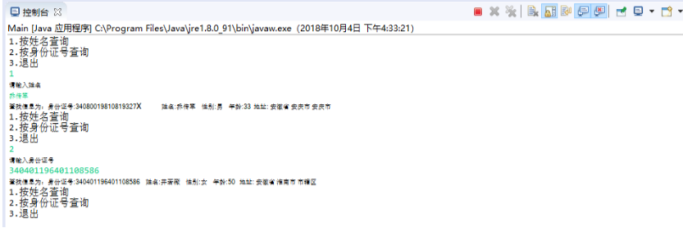
实验总结:
通过这一周的学习以及自己在后期的自学过程当中,我深入了解了什么叫做继承,以及在继承中所包含的类型有哪些。继承是用已有类来构建新类的一种机制,当定义了一个新类继承了一个类时,这个新类继承一个类时,这个新类就继承了这个类的方法和域。而且继承是具有层次的,其代码也是可重用的,可以轻松定义子类。首先在学习过程当中我们学习了类,超类和子类的定义,让我明白了父类和子类时相对的。还学习了泛型数组列表与对象包装器与自动装箱,在后面还介绍了反射的概念,它是在程序运行期间发现更多的类及其属性的能力。并体会颇多,在今后的日子里我会好好深入学习java知识。